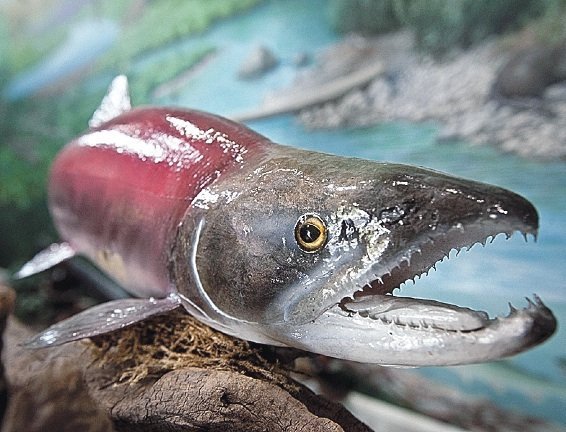forum
library
tutorial
contact

Delisting Idaho's Sockeye
is an Obtainable Goal
by Scott Levy
Idaho Mountain Express, October 3, 2014
|
the film forum library tutorial contact |

|
Delisting Idaho's Sockeye
by Scott Levy
|
 From some four million eggs (brood year 2010) laid within granitic gravels of soon-to-freeze-over Redfish Lake, two hundred thousand inch-long sockeye are flushed to the sea by the spring freshet of 2012. Foraging on tasty North Pacific krill, the "bluebacks", so called by Alaskan fishermen, grow to four or five pounds.
From some four million eggs (brood year 2010) laid within granitic gravels of soon-to-freeze-over Redfish Lake, two hundred thousand inch-long sockeye are flushed to the sea by the spring freshet of 2012. Foraging on tasty North Pacific krill, the "bluebacks", so called by Alaskan fishermen, grow to four or five pounds.
Following two or three years at sea, some four thousand survivors find their way back to the Columbia River to begin their uncertain journey back to Idaho. Nearly three thousand will succeed the 750-foot climb through 450 miles of man-made reservoirs, the taste of pesticides, pharmaceuticals, PCB, PBDE and DDT greet them along their way.
The Idaho Statesman headline "Sockeye run tops modern record", tells us of some fourteen hundred adults reaching their 6550-foot elevation natal waters beneath Idaho's Mount Heyburn and Grand Mogul. Not eating on the return home, their bodies now transformed for their final act, they spawn a new generation before leaving their carcass of marine-derived nutrients along the Redfish Lake shore. Collectively they leave some million and a half eggs ahead of the coming winter freeze.
One and half million eggs from four million a generation before, therein lies the problem. This is not sustainable. With drastic human intervention, Idaho's sockeye escaped near-certain extinction, yet the population continues to decline. The production of hatchery fish can mask the underlying problem but it will not solve it.
Near Pocatello Idaho, the Springfield Hatchery provides life support for Idaho's Sockeye. By 2020, production there will quadruple or quintuple the current numbers of hatchery fish. Every May, some one million inch-long juveniles will be dumped into the overflowing outlet of Redfish Lake. This "swamping" will fill the bellies of ducks, eagles, hatchery steelhead and bull trout, and otherwise help to conceal the more savvy natural-origin migrants.
According to plan, more "record number" returns will follow, more spawned out carcasses will decay along the shore, more carbon, nitrogen and phosphorous will feed the lake's waters and surrounding forest. The hope is that these added nutrients will greatly boost the lake's productivity of natural-origin migrants. But relying on hope is not the same as relying on science. A good hard look at Lower Snake reservoir removal is worth considering. Lower Granite, Little Goose, Lower Monumental and Ice Harbor may need to go.
If we are to delist our Sockeye, obviating any need of Endangered Species Act protections, a thousand fish must be replaced by more than one thousand. Population growth is essential for delisting to take place.
With both ecologic and economic arguments, the majority opinion of Western Division of American Fisheries Society recommends that four federally-owned dams and reservoirs need to go: Lower Granite, Little Goose, Lower Monumental and Ice Harbor. All of the benefits of these four dams, each adding just one percent to the Northwest electric supply, can continue to be provided without the dams actually being in place. Wind energy, irrigation pumps and rehabilitated rail lines are not rocket science.
The recently proposed Sockeye Recovery Plan seeks to budget $100 million dollars over the next twenty-five years for research, monitoring, hatchery and habitat effort. If numeric goals were exceeded, returning four thousand adults per year would equate to one thousand dollars per fish -- money that may well be spent elsewhere and to greater effect.
Energy conservation programs are currently replacing the equivalent of one Lower Snake dam each year. These so-called "negawatts" provide the cheapest energy available and electric bills will continue downward even with four fewer government-owned dams. We simply do not need them.
Delisting Idaho's Sockeye is an obtainable goal. Now is a good time for some serious discussion.

learn more on topics covered in the film
see the video
read the script
learn the songs
discussion forum
